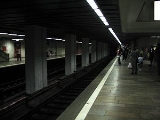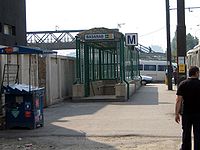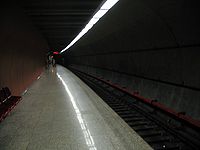
Basarab metro station
Encyclopedia
Basarab is a metro station in Bucharest
. Despite its name, it is not located near the Basarab railway station
(Gara Basarab), but rather to the north-eastern end of Gara de Nord
, Bucharest's main railway station, at the intersection of Calea Griviţei and Nicolae Titulescu Avenue. Access to Gara Basarab proper (a small annex of Gara de Nord, used mainly for commuter trains) is possible via an underground tunnel crossing the 14 platforms and tracks of Gara de Nord
Access to Gara Basarab proper (a small annex of Gara de Nord, used mainly for commuter trains) is possible via an underground tunnel crossing the 14 platforms and tracks of Gara de Nord
.
The Basarab metro station was added after Line M1 was finished, with the sole intent of providing a means to change from M1 to M4 (while initially the trains of M1 and M4 were supposed to run on the same trackage up to Crângaşi
, a change of project in 1988 involved building separate trackage for each, with the trains running exclusively under Calea Griviţei and no longer reaching Crângaşi
, with access between the two at Gara de Nord 1 being impossible without leaving the system and paying for a fare again). The station is extremely close to the Gara de Nord metro station (not only are the lights of Basarab easily visible through the tunnel at Gara de Nord 2, but both stations are built below the platforms of Gara de Nord railway station), a situation uncommon for a system characterized by large distances between stations (up to 2 km / 1.2 mi). The construction of the station began in November 1990 and was completed in January 1992 for the M1 section and March 2000 for the M4 section.
 The station has four tracks on the same level, two of the tracks on each side of the station, and two as a pair in the center, leaving space for two wide platforms. The two central tracks are used by M1 while the outermost tracks are used by M4, leaving one platform to be used for northbound trains and one for southbound trains. Each platform has very long and thick wall-like columns, spanning for three quarters of the station, allowing access between the M1 and M4 sections through 6 points. This was done to easier conceal the work being done on the M4 side while passengers were using the M1 side. The design of the two sides, although part of the same station and even the same platform, is quite different - the M1 side features white-grey marble
The station has four tracks on the same level, two of the tracks on each side of the station, and two as a pair in the center, leaving space for two wide platforms. The two central tracks are used by M1 while the outermost tracks are used by M4, leaving one platform to be used for northbound trains and one for southbound trains. Each platform has very long and thick wall-like columns, spanning for three quarters of the station, allowing access between the M1 and M4 sections through 6 points. This was done to easier conceal the work being done on the M4 side while passengers were using the M1 side. The design of the two sides, although part of the same station and even the same platform, is quite different - the M1 side features white-grey marble
walls and floors, with a grey travertine
roof arranged as to form a square grid, lit by square white fluorescent neon lights built inside the grid while the M4 side features orange synthetic walls, black Azul Noce granite on the floors, and yellow neon lighting running in a continuous line along the station, above the tracks. The station is usually announced in trains at Gara de Nord, Griviţa and Crângaşi as "the place to switch between M1 and M4".
Bucharest
Bucharest is the capital municipality, cultural, industrial, and financial centre of Romania. It is the largest city in Romania, located in the southeast of the country, at , and lies on the banks of the Dâmbovița River....
. Despite its name, it is not located near the Basarab railway station
Basarab railway station
Basarab railway station in Bucharest is situated near the city's main station, Gara de Nord. Built in 1959 to handle a share of the main station's traffic and mainly used by short-distance commuter trains run by Căile Ferate Române, it is often considered to be an annex of Gara de Nord, to which...
(Gara Basarab), but rather to the north-eastern end of Gara de Nord
Gara de Nord
București Gara de Nord is the main railway station in Bucharest and the largest railway station in Romania...
, Bucharest's main railway station, at the intersection of Calea Griviţei and Nicolae Titulescu Avenue.

Gara de Nord
București Gara de Nord is the main railway station in Bucharest and the largest railway station in Romania...
.
The Basarab metro station was added after Line M1 was finished, with the sole intent of providing a means to change from M1 to M4 (while initially the trains of M1 and M4 were supposed to run on the same trackage up to Crângaşi
Crângasi metro station
Crângaşi is a metro station in the Crângaşi neighborhood, northwestern Bucharest.It was opened to the public in December 1984 as a terminus of the M1 line . The station is unusual in that it has three tracks on the same level, one of which has never been used by passengers...
, a change of project in 1988 involved building separate trackage for each, with the trains running exclusively under Calea Griviţei and no longer reaching Crângaşi
Crângasi metro station
Crângaşi is a metro station in the Crângaşi neighborhood, northwestern Bucharest.It was opened to the public in December 1984 as a terminus of the M1 line . The station is unusual in that it has three tracks on the same level, one of which has never been used by passengers...
, with access between the two at Gara de Nord 1 being impossible without leaving the system and paying for a fare again). The station is extremely close to the Gara de Nord metro station (not only are the lights of Basarab easily visible through the tunnel at Gara de Nord 2, but both stations are built below the platforms of Gara de Nord railway station), a situation uncommon for a system characterized by large distances between stations (up to 2 km / 1.2 mi). The construction of the station began in November 1990 and was completed in January 1992 for the M1 section and March 2000 for the M4 section.

Marble
Marble is a metamorphic rock composed of recrystallized carbonate minerals, most commonly calcite or dolomite.Geologists use the term "marble" to refer to metamorphosed limestone; however stonemasons use the term more broadly to encompass unmetamorphosed limestone.Marble is commonly used for...
walls and floors, with a grey travertine
Travertine
Travertine is a form of limestone deposited by mineral springs, especially hot springs. Travertine often has a fibrous or concentric appearance and exists in white, tan, and cream-colored varieties. It is formed by a process of rapid precipitation of calcium carbonate, often at the mouth of a hot...
roof arranged as to form a square grid, lit by square white fluorescent neon lights built inside the grid while the M4 side features orange synthetic walls, black Azul Noce granite on the floors, and yellow neon lighting running in a continuous line along the station, above the tracks. The station is usually announced in trains at Gara de Nord, Griviţa and Crângaşi as "the place to switch between M1 and M4".

